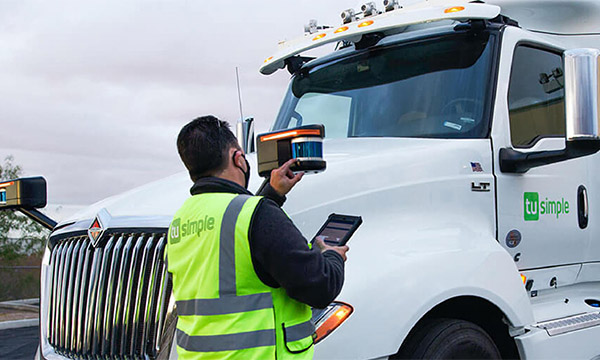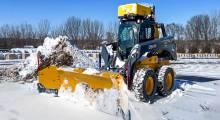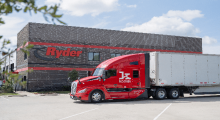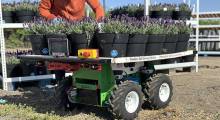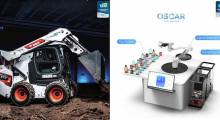As autonomous vehicles move from proofs of concept to trials on public roads, developers need to demonstrate and protect their innovations in a competitive industry. TuSimple Holdings Inc. in August announced that it had received 72 patents in the first half of 2023.
“We have been working on developing practical technologies and intellectual property to improve and to bring autonomous trucking to market, which is demonstrated by our growing collection of patent assets,” claimed the San Diego-based company. TuSimple said in a release that its portfolio includes systems for advanced fueling options, 360-degree perception, and onboard sensor-cleaning systems.
It also highlighted patents for systems to reduce energy consumption, sharing information about road closures between autonomous vehicles (AVs) and updating Autonomous Freight Network routing plans, and a Mobile Launchpad for AVs to reduce the need for driver interventions during the loading and landing process.
“TuSimple’s patent portfolio reflects our best-in-class technology development and strong progress in bringing autonomy to the market,” stated Paul Liu, global head of intellectual property at TuSimple. He spoke with Robotics 24/7 about TuSimple's patent portfolio and technology strategy.
TuSimple builds portfolio with the future in mind
Why is this intellectual property (IP) protection important?
Liu: Patents can be used to track the progress of innovation and achieving a return on investment [ROI]. It's documenting what you actually have, and there's also a financial aspect, especially if you think about how IP trails development of technologies.
Once there's revenue, there's a percentage of claims by other companies. We need to have a portfolio for counter-assertions and other use cases. Our portfolio also ensures that our portfolio is tracking with the rate of innovation, which is important.
It comes down to having that ROI and defensive rings around IP. Autonomous vehicles are a nascent space. It's like how smartphones started off with R&D and slowly became more competitive with monetization. Once a technology matures, you can have patent wars.
The time to harvest IP is now, when innovation is happening. We've sat down with our executives to discuss what's valuable and protect future outcomes. That's long-term strategic thinking.
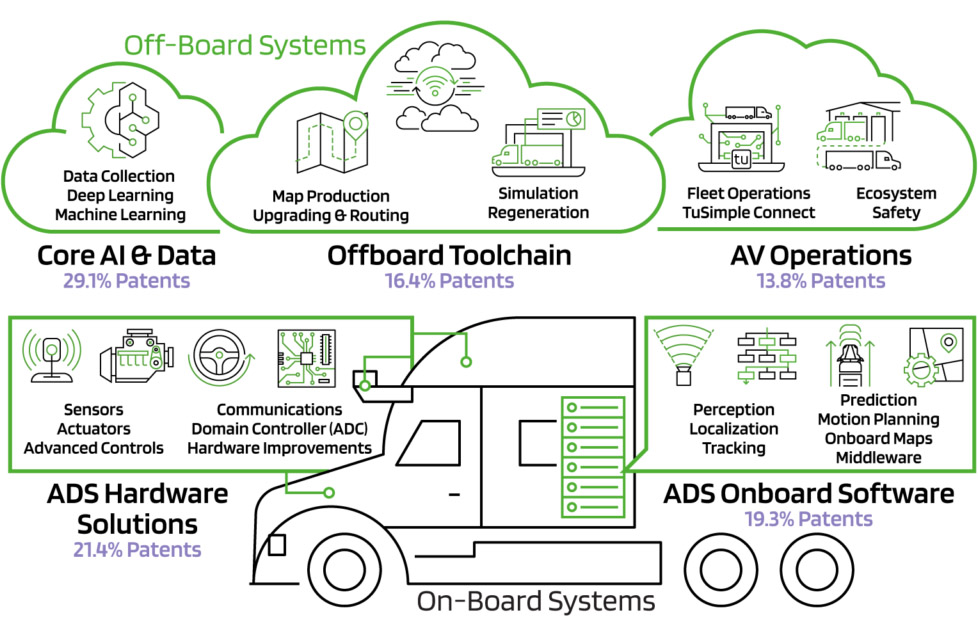
The infographic above shows the distribution of TuSimple's patents. Do you have a percentage for those devoted to safety features?
Liu: Some things are open to interpretation, such as the application of the broad term of “safety,” which can even lead to different patent outcomes. There are single versus multiple classifications, and we made a best-faith effort to show the technology coverage of our portfolio.
We don't have an exact percentage because of the difficulties in clamping that down, but safety is front of mind in many things, such as sensor hardware and ecosystem safety. We've taken great efforts to develop safe, efficient vehicles.
Patents describe autonomous truck behaviors
Can you give an example of a truck behavior that would be modified under Patent 10678234 to minimize energy cost?
Liu: This describes a lot of possible routes. When you drive, how do you drive to minimize energy cost, and how do you do it in an autonomous truck?
The patent describes evaluating the predicted energy consumption rates for different potential routings and then selecting the potential routing that reduces energy consumption. These may include, for example, directing the vehicle to pass another vehicle, adjusting speed or heading to maintain separation from other vehicles, drafting a leading vehicle in front of the vehicle, maneuvering the vehicle in turns, or performing controlled acceleration.
We're talking to the U.S. Patent and Trademark Office [USPTO] on a patent continuation. We're basically determining where the invented pieces are and are still honing details. It's early days, rich with invention.
Does TuSimple's system under Patent 11458993 also update when an obstacle is removed? Do you retain historical data, and does it get compared with other sources of road information?
Liu: The patent describes updates when an obstacle is removed. For instance, these obstacles could be removal of obstructing debris on the road like a couch, removal of a road closure, removal of blocking objects like traffic or other congestion, and removal of a construction zone.
The patent describes how historical data may be retained and compared with other sources of road information. For example, the system may determine an estimated completion time of an obstacle, such as from a construction zone, based on saved published information, such as published planned construction-zone activity, and reroute vehicles accordingly during that period of planned construction zone activity.
The system can also compare this information with live data from the vehicles and other data sources, such as crowdsourced traffic data captured from external sources or live traffic reporting. It's an interesting part of a series of vehicle operations, monitoring road defects, construction zones, and the like in addition to fleet management.
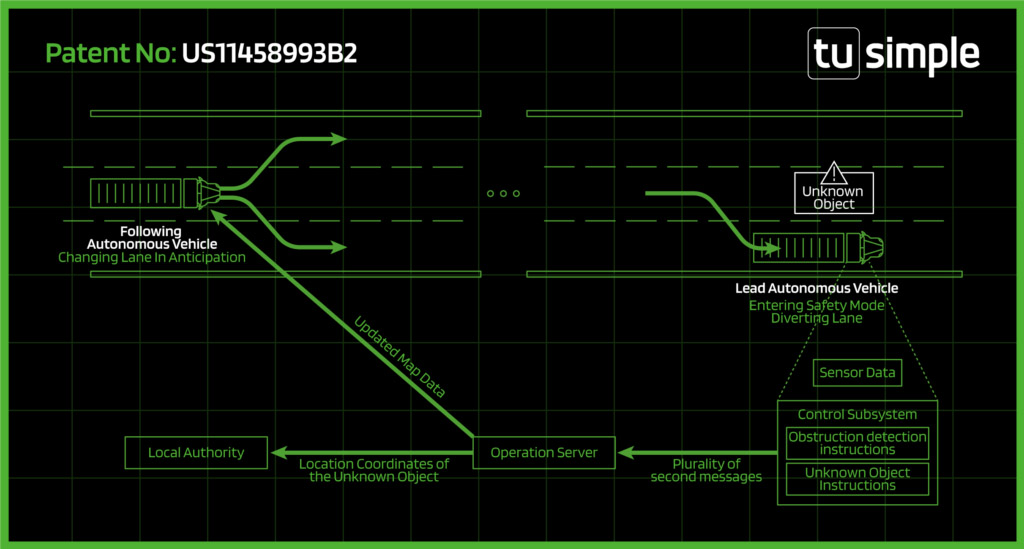
Is there a human-supervised aspect to the truck-launching system described in Patent 11380109B2? Does it require specific sensors, or is it more about the processing of signals?
Liu: We’re talking about a safe transition from autonomous to non-autonomous mode. The patent describes how a launchpad can be initiated manually or automatically without a human.
Obstructions or other hazards may be detected at or around the launchpad using sensors and/or be based on human input. This type of human input may include a confirmation of whether any detected obstructions or hazards are removed, which can also be used to flag abnormal sensor performance for maintenance.
This system discusses both the usage of specific sensors and the processing of signals. For example, a variety of specific sensors can be utilized for safe truck-launching, such as image sensors, lidar sensors, motion sensors, microphones, and the like. The data from these sensors can then be processed to determine that it is safe to perform the transition to autonomous operations.
One exciting thing is the patent’s discussion of how to safely re-launch autonomy, such as if the vehicle pulls over on the road due to a flat tire or other issues. TuSimple is sweating the details on safe, reliable transport.
There's a line between changing parts and patentable tech and processes. That's why a lot of patent development requires us to have a close relationship with the engineering team.
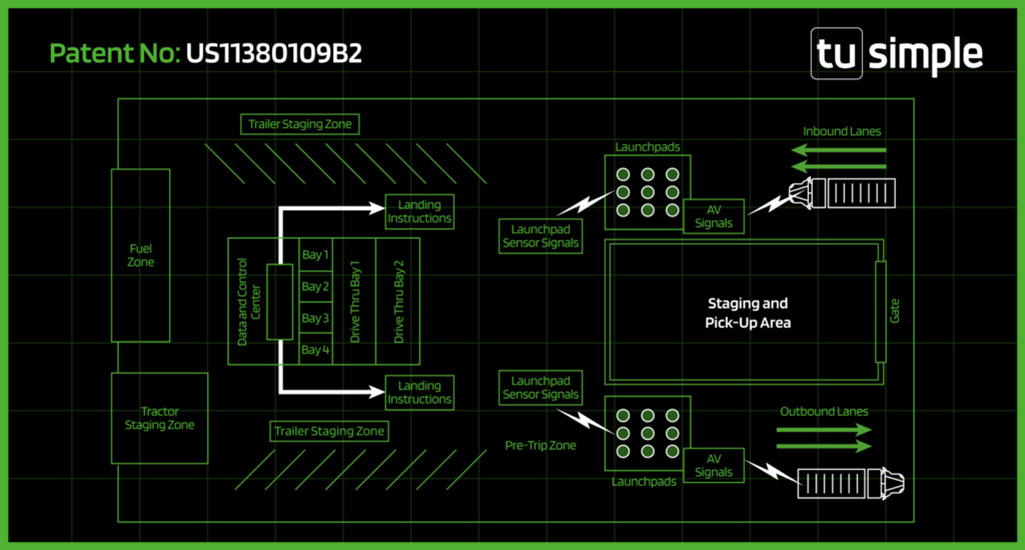
TuSimple looks down the road
Does TuSimple have plans to license any of its technologies?
Liu: We’re open to typical industry standards and are crafting appropriate provisions.
For business development, it's more of a big question of “How do we plan on moving our technology forward?” Licensing is one way, and we have a good corpuse of technologies to potentially license.
Do you expect TuSimple's pace of patent filings to continue? Do you monitor others' filings?
Liu: I expect the pace of filings to align with and to protect the development of our technology. We'll continue to have significant patent filings, but I don’t expect it to always be this way. They may become fewer as innovation becomes incremental.
Protection of IP is really a long game. Its financial value comes later with wide adoption. We file something because we believe we have something innovative and valuable.
Not only do we watch what others do, but the USPTO also does that to see what the rest of the world is doing. We do our own due dilligence to see what competitors are doing generally.
How much do autonomous trucks have in common with self-driving cars and mobile robots?
Liu: Autonomy tech is autononomy tech—there’s a lot of overlap because it all has to solve the same kinds of problems.
At the same time, trucking is different. Sensors are higher, they need to see further out, and there are articulated vehicles with trailers, more draft, fuel consumption issues, more concerns about safety at high speed.
Long-haul trucking is fragmented in the U.S., and we provide a solution to the dearth of drivers, especially in the middle mile. This technology would address an actual need in the market.
TuSimple now has over 600 patents globally, which is a point of pride. It reflects our commitment to rigorously capturing innovation.
About the Author
Follow Robotics 24/7 on Linkedin
Article topics
Email Sign Up

